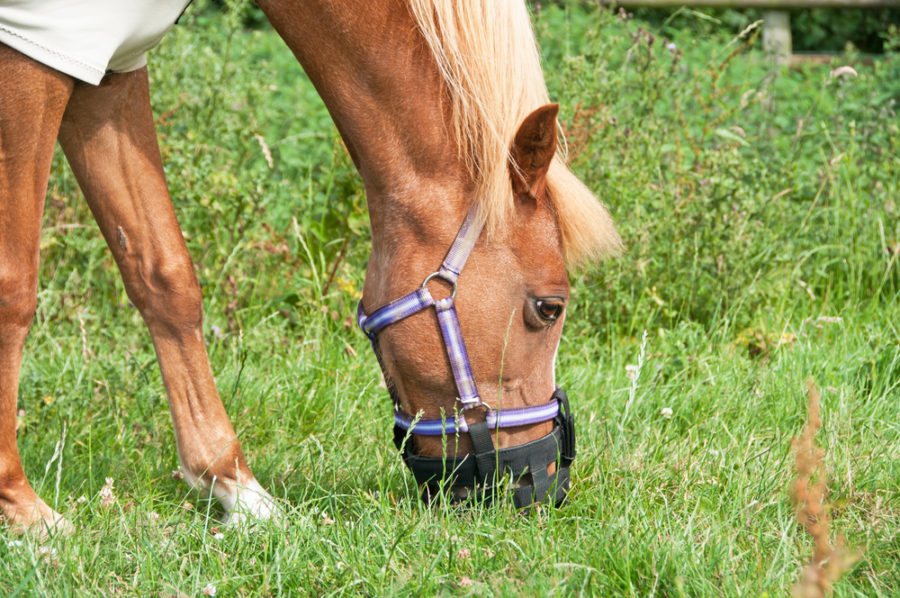No one wants to admit their horses are getting a bit overweight. But the reality is that weight is one of the most important things for us to monitor. You may want to consider a grazing muzzle as part of your own horse’s diet plan.
Research shows that upwards of 51% of American horses are obese. In the UK, meanwhile, a study estimated there are 8,000 cases of laminitis per year (that’s 7.1% of the population). The most serious complications arising from obesity tend to result from horses and ponies on grass. Grazing muzzles can reduce your horse’s caloric intake, while allowing him to remain in a healthy pasture situation and enjoy the company of his herd mates. He’ll benefit from more exercise, reduced stress, and less unnecessary food.
Equine metabolism and the modern horse
Horses in the wild are on a constant search for food. They graze on whatever scrub, grass and weeds are available for the greater part of the day, with only about four hours of rest. During this time, they are moving constantly, except for the relatively short periods spent sleeping. In contrast, the diet and lifestyle of the modern horse consist of readily available commercial feeds, rich grass designed for fattening cattle, and limited exercise.
A horse’s natural metabolism is designed to adapt to periods of poor feed availability — for example, during a drought or winter. The wild horse benefits from the flush of carbohydrates that spring grasses bring. This vital nutrition helps them regain the weight that they likely lost during the period of drought or famine.
A domesticated horse does not generally face these issues. Most conscientious horse owners feed to maintain a good healthy weight all year long. So the additional sugars and calories from fresh grass are not necessary and can even be detrimental. Excess sugars increase inflammation and often lead to debilitating laminitis, insulin resistance, and even arthritis from carrying around excess weight.
Determining if your horse needs a grazing muzzle
It’s time to do a serious evaluation of your horse’s weight. Go to your local feed store and find a weight tape (they’re often free). In a small notebook, keep track of his measurements or body condition score every two weeks during the grass-growing season. While tracking his measurements, touch his body to feel for the following:
Ribs – You should be able to find and feel them.
Crest of the neck – The crest should be soft and not excessive in size.
Tail – No fat pads should be present around the tail. Any fat he does have should be smooth and soft.
If you can’t feel his ribs, his fat is hard or lumpy, and there are extra fat pads present – your horse may need a muzzle, or at least some dietary adjustments.

Muzzle fitting and use
Horses do not love to wear muzzles, so it’s important to be sure the one you choose fits well. The muzzle needs to have enough space from front to back to allow your horse to chew naturally. This can vary depending on the shape of his head. To check, watch your horse as he grazes, or offer a treat and watch carefully – there should be clearance at all times, though it does not have to be large. As a starting guide, a space of about two fingers’ width should be present behind the jawbones at the back.
For an average horse, the muzzle should attach to the halter and hang down, leaving about ½” between the nose and the bottom. Smaller ponies will need less space. For clever “Houdini” horses that are good at escaping, be creative and add straps. A browband or chin strap is very useful. Be sure to adjust the chinstrap so it goes above the cheek, rather than low on the back of the jaw, to help keep it in place. Use the internet as a resource to learn what other people have tried, and see what works for your horse.
Safety precautions
Muzzles must be used with breakaway halters in case the horse catches it on something, or more commonly, tries to rub it off. Muzzles that are too large can get caught on things more easily. Keep the muzzle clean, especially in warm damp weather. Mold can grow in the webbing and cause allergies.
If another horse is bullying yours and he cannot defend himself with the muzzle on, change his companions in the field. It is not fair for the muzzled horse to get picked on.
Easing the transition to a grazing muzzle
- Feed your horse a treat when putting the muzzle on to help make the experience as pleasant as possible.
- Adjust the length of time the horse wears the muzzle, based on the amount of grass present. This will vary from season to season and with the influence of rainfall, sunshine and temperature. So keep an eye on grass growth, not just the season.
- Add real sheepskin to the halter or muzzle if rubs appear.
- Use an adjustable muzzle if you are getting rub marks, and shape it to the horse’s head.
- Check the size of the holes in the bottom of the muzzle on a weekly basis. It is very common for a horse to chew out a larger hole, rendering the muzzle ineffective.
A grazing muzzle can help ward off those extra pounds and keep your horse at a healthy weight. Give it a try and see if it works!








